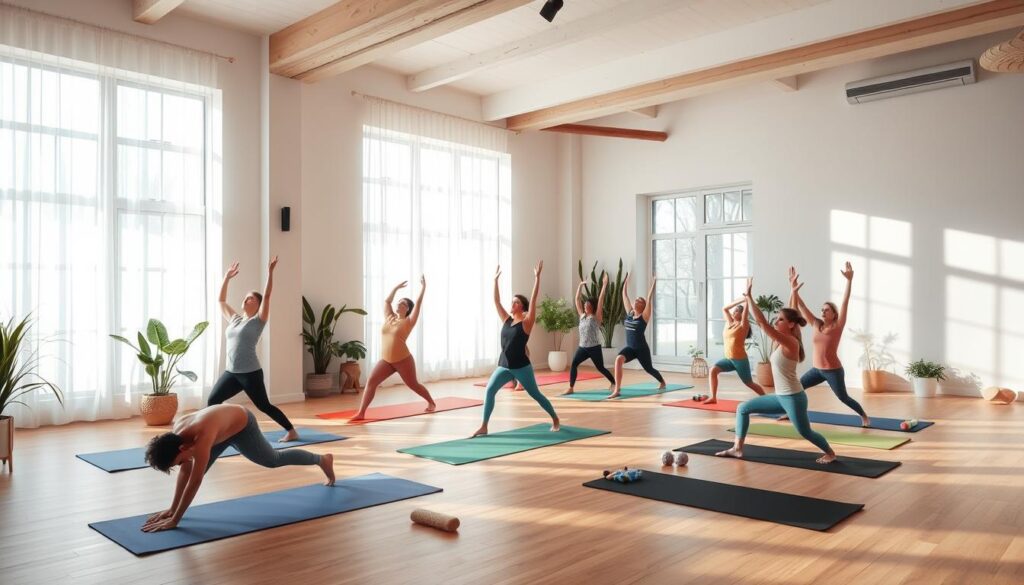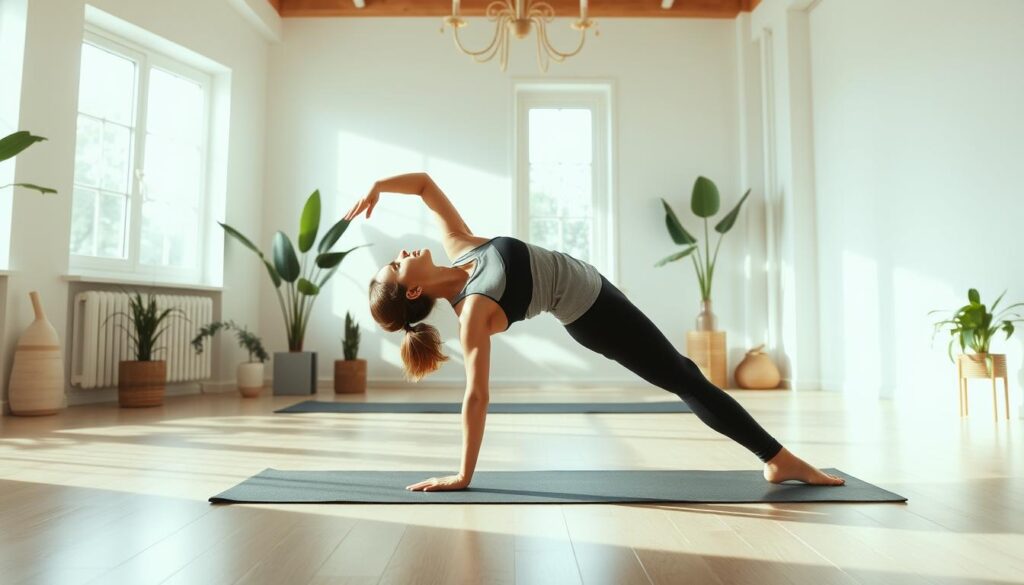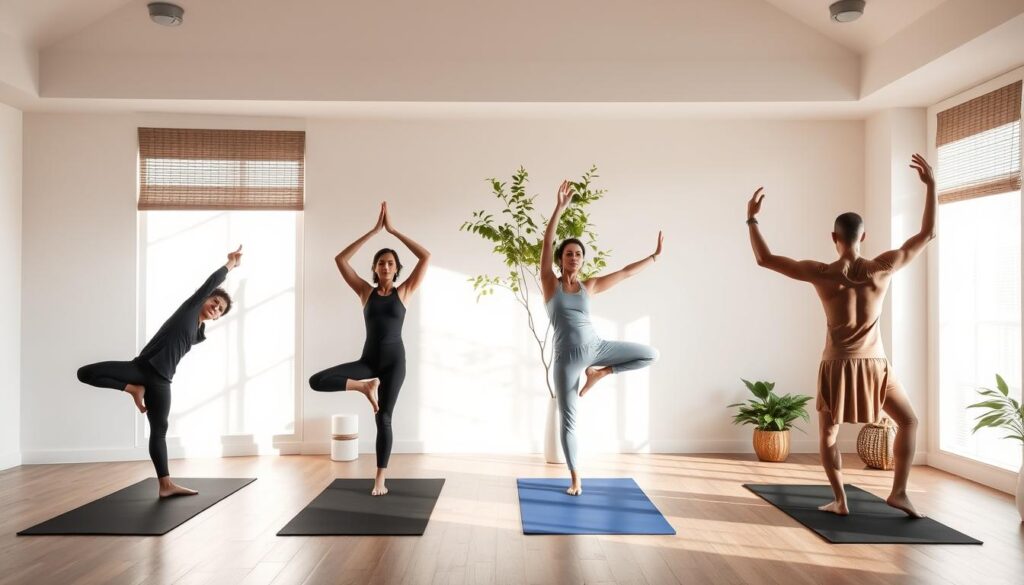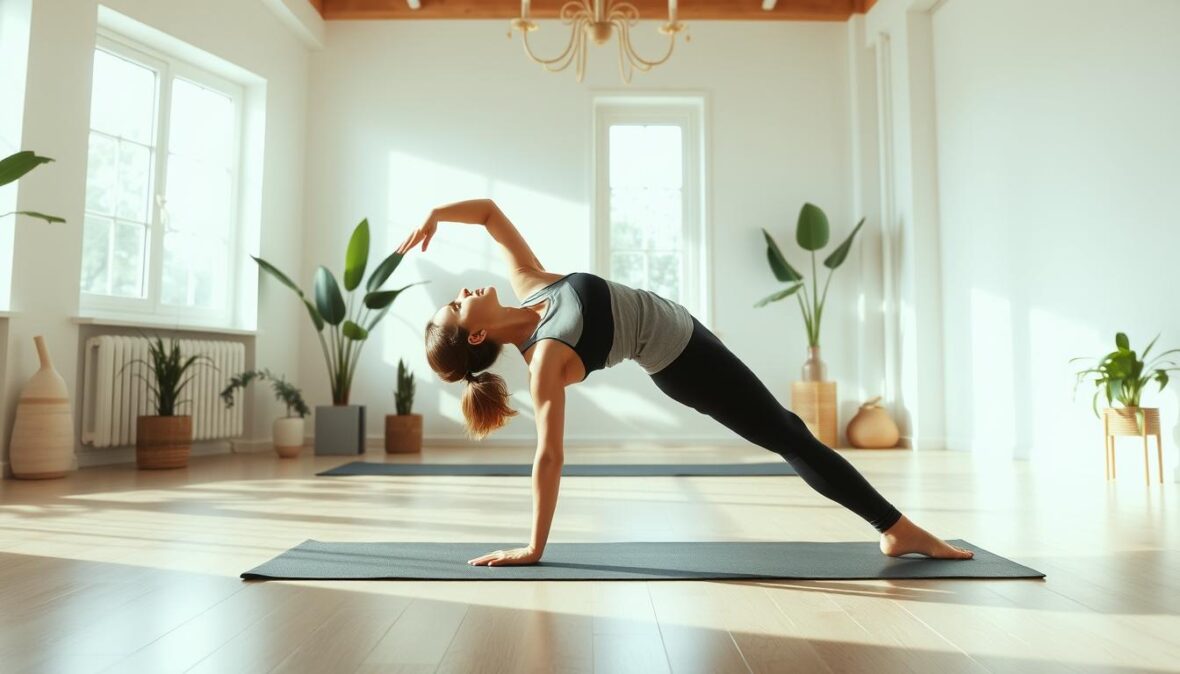Exploring yoga is a journey of self-discovery. Knowing the different levels of practice is essential to finding the right fit. Yoga studios use terms like “Beginner,” “Intermediate,” and “Advanced” to describe their classes. This can confuse both new and experienced practitioners.
Before, it was thought that you start as a beginner and move up to advanced levels over time. But, with a focus on trauma-informed practices in the last decade, studios are changing how they name their classes.
Labeling yoga poses or classes as beginner, intermediate, and advanced has been criticized. It’s seen as reducing yoga to physical postures and focusing too much on mastering hard poses. The industry is now pushing for more accurate and inclusive class titles and descriptions.

Key Takeaways
- Yoga levels are often defined as beginner, intermediate, and advanced, but these labels are being reconsidered.
- Understanding your yoga level is crucial for selecting appropriate classes and progressing safely in your practice.
- Yoga studios are moving towards more precise and inclusive class descriptions beyond just physical posture levels.
- Progression in yoga is not just about mastering advanced poses, but also about personal growth and development.
- Finding the right yoga level for your current abilities and goals can help you maximize the benefits of your practice.
Understanding the Importance of Yoga Level Classification
Yoga is for everyone, from beginners to experts. Knowing your yoga level is key for safety, growth, and a strong start.
Safety and Injury Prevention
Yoga levels help avoid injuries by matching poses with your skill. Trying hard poses without the right strength or experience can hurt you. Staying in your zone and moving up slowly keeps you safe and healthy.
Personal Growth and Development
Knowing your yoga level lets you grow and improve. Start with simple poses and move up as you get better. This way, you learn the basics well before tackling harder stuff. It helps your body, mind, and spirit grow.
Building a Strong Foundation
Learning basic yoga poses and principles is vital for success. Beginners who focus on proper alignment and breathing are ready for harder levels. This leads to a fulfilling and lasting yoga journey.
Understanding yoga levels is important. It keeps you safe, helps you grow, and builds a strong base for your yoga journey.
How to Know Your Yoga Level
Finding out your yoga level means looking at your physical skills, how well you know poses, and how comfortable you are in class. You should think about your flexibility, strength, balance, and how well you can control your breath. Beginners start with simple poses and learning how to stand right. Those who are more advanced can try harder poses and more complex sequences.
Knowing your yoga level is important. It helps you choose the right class for you. You can figure it out by yourself or ask a teacher who knows a lot about yoga.
Here are some tips to understand the different yoga levels:
- Yoga Level 1 (Beginner): Great for newbies or those who don’t exercise much. Classes move slowly and teachers explain a lot.
- Yoga Level 2 (Experienced Beginner): For those who have done some yoga and want to learn more. Classes are a bit faster, and you’ll start to learn hand mudras and breathing techniques.
- Yoga Level 3 (Intermediate): For people who know the basics well. You’ll try harder poses, learn to balance on your hands, and focus more on breathing and being mindful.
- Yoga Level 4 (Advanced): For very experienced yogis. You’ll work on extreme flexibility, balance, and controlling your breath. Classes are very fast and challenging.
Remember, yoga levels are not set in stone. It’s a journey, not a goal. You might not always feel like you’re getting better, but that’s okay. The most important thing is to enjoy the journey and listen to your body. Teachers can help you find the right level for you based on your skills and goals.
| Yoga Level | Key Characteristics |
|---|---|
| Level 1 (Beginner) | Slow pace, clear instructions, focus on basic poses and alignment |
| Level 2 (Experienced Beginner) | Faster pace, more challenging poses, introduction to mudras and pranayama |
| Level 3 (Intermediate) | Challenging poses, inversions, arm balances, deeper focus on breath work and mindfulness |
| Level 4 (Advanced) | Highly challenging poses, extreme flexibility, stability, breath control, and intention setting |
Level 1: Beginning Your Yoga Journey
Starting your yoga journey begins with Level 1 classes. These classes focus on the basics. They teach basic poses, proper alignment, and breathing techniques called pranayama.
The classes move at a slower pace. This allows for clear instructions and adjustments. It makes sure the practice is safe and accessible for everyone.
Basic Poses and Alignment
Level 1 yoga classes teach the basics. You’ll learn poses like Mountain pose, Downward-facing dog, and Cobra pose. You’ll also learn Warrior I and II, Child’s pose, and Plank pose.
Learning proper alignment is key. It helps prevent injuries and builds a strong practice.
What to Expect in Beginner Classes
Beginner yoga classes are calm and supportive. Instructors give detailed instructions and offer variations for different levels. You’ll learn at your own pace.
Expect a gentle flow with chances to pause and ask questions. The focus is on building confidence and learning yoga terminology (including Sanskrit names).
Essential Foundational Postures
- Mountain Pose (Tadasana)
- Downward-facing Dog (Adho Mukha Svanasana)
- Cobra Pose (Bhujangasana)
- Warrior I (Virabhadrasana I)
- Warrior II (Virabhadrasana II)
- Child’s Pose (Balasana)
- Plank Pose (Chaturanga Dandasana)
These poses are the foundation for more advanced practices. Mastering them creates a strong yoga level 1 base. It supports growth and exploration in jivamukti yoga and other styles at many yoga studios.
Level 2: Transitioning to Experienced Beginner
After mastering the basics in Level 1, it’s time to move up to Level 2. These classes introduce more complex poses and flowing sequences. They build on what you’ve learned, making your practice more challenging.
In Level 2, you’ll learn to link your breath with your movements. You’ll also discover hand mudras, pranayama, and bandhas. These new tools will deepen your practice. You’ll try poses like Half Moon, Eagle, and Camel, which will test your balance and strength.
Level 2 classes are designed to take your practice to the next level. You’ll face new challenges, but your instructor will guide you. This will help you become more well-rounded in your yoga journey.
| Yoga Level | Intensity Level | Percentage |
|---|---|---|
| Beginner (Level 1) | Low Intensity | 33% |
| Beginner (Level 1) | Medium Intensity | 66% |
| Beginner (Level 1) | High Intensity | 99% |
| Improver (Level 2) | Low Intensity | 33% |
| Improver (Level 2) | Medium Intensity | 66% |
| Improver (Level 2) | High Intensity | 99% |

Remember, moving to yoga level 4 should be slow and focused. With patience and hard work, you’ll keep getting stronger, more flexible, and confident in your yoga journey.
Level 3: Exploring Intermediate Practice
Yogis moving from beginner levels are drawn to the intermediate yoga practice. This stage focuses on advanced pose variations, deeper breath work, and building strength and flexibility.
Advanced Pose Variations
Intermediate yoga classes introduce poses like Crow, Wheel, and Eight Angle. These poses require a strong foundation and a willingness to push limits. Students need to understand basic poses and alignment to safely try these complex asanas.
Breath Work and Flow
In level 3 yoga classes, breath and movement are closely linked. Practitioners learn to breathe in sync with poses, creating a meditative experience. Learning pranayama (breath control) techniques enhances the practice.
Building Strength and Flexibility
The intermediate yoga practice focuses on full-body strength and deep backbends. Students face more challenging balancing poses, arm balances, and inversions. The practice is about pushing limits and growing physically and mentally.
Yogis at the intermediate level feel empowered and discover more about themselves. The challenges in level 3 classes offer chances for growth, both on and off the mat.
Level 4: Advanced Yoga Practice
For those who have been practicing yoga for years, the advanced level is a big challenge. These classes are for those who have worked hard to improve their skills. They offer a chance to try complex poses, increase flexibility and stability, and get better at controlling their breath.
Students might learn poses like Forearm Headstands, One-Handed Handstands, Scorpion pose, and King Pigeon pose. These poses are very hard and need a lot of strength, balance, and awareness of the body.
These classes are not for beginners or even those who are not very experienced. They can be dangerous because of the risk of injury. You need to know the basics of yoga, how to prepare for handstands, and understand the foundational yoga principles like mudra and breath control.
For those who want to go deeper in their yoga journey, advanced classes can be very rewarding. But, it’s important to progress carefully and listen to your body. With hard work and respect for the practice, advanced yoga can bring great strength, flexibility, and peace.
Different Types of Yoga Classes and Their Intensity Levels
Yoga offers many styles and intensity levels. Each type suits different needs and goals. Knowing about various yoga styles helps find the right class for you.
Gentle and Restorative Styles
Gentle yoga, like Hatha and Restorative, is low intensity. It’s great for beginners or those wanting to relax. These classes focus on slow movements, longer holds, and using props.
They improve flexibility, reduce stress, and boost well-being.
Dynamic and Power-Based Practices
Dynamic and power-based yoga, such as Vinyasa and Ashtanga, are more challenging. They are for those who want to push their limits. These classes are fast-paced and include strong poses.
They help you grow in your practice and try more complex poses.
Specialized and Traditional Forms
Specialized yoga, like Bikram and Iyengar, has unique approaches. Bikram is done in a hot studio, making it intense. Kundalini focuses on breath and spiritual growth. Iyengar uses props for precise alignment.
These styles offer focused practices for specific goals.
Knowing about different yoga classes helps you choose the right one. Whether you’re new or experienced, there’s a class for you.
| Yoga Style | Intensity Level (based on oxygen consumption) | Intensity Level (based on heart rate) |
|---|---|---|
| Hatha, Gentle, Soft Flow | Light | Light to Moderate |
| Yin, Bikram | Light | Moderate to Vigorous |
| Ashtanga, Vinyasa, Rocket | Moderate | Moderate |
| Power Yoga | Moderate | Moderate |
Physical and Mental Benefits Across All Levels
Yoga is great for everyone, whether you’re just starting or have been practicing for years. It improves your circulation, breathing, flexibility, and sleep. Yoga makes your body and mind better at every level.
Yoga helps build muscle strength. Downward dog, upward dog, and plank strengthen big muscles. This improves your posture and balance. Even beginners can see their flexibility improve.
Yoga also helps your mind and emotions. The walk around the room offering of breath work and meditation reduces stress. It brings calmness and peace. Yoga is a classes are a good choice for those fighting anxiety and depression.
Yoga benefits more than just you. Yogis who have been practicing see better lung function, less inflammation, and lower heart disease risk. Studies show yoga helps with arthritis, chronic pain, and women’s health issues.
Yoga is good for everyone, no matter your skill level. It makes life more balanced and fulfilling. Whether you’re new or advanced, yoga’s power is endless.
Tips for Progressing Through Yoga Levels
Going through yoga levels is rewarding but takes time. It needs patience, regular practice, and knowing yourself. Use mindful practice techniques to move up safely and wisely.
Mindful Practice Techniques
Always listen to your body and respect its limits. Don’t push too hard to avoid injuries. Focus on the right form and alignment to build a strong base. Take it easy and celebrate small wins.
When to Move to the Next Level
You can move up when you’re comfortable with current poses and ready for new ones. It’s always a good idea to get advice from experienced teachers. They can tell if you’re ready and give you tips.
Maintaining Safety During Progression
As you get better, keeping safe is key. Start with easier poses and don’t compare yourself to others. You’ve never done this before, so take it easy and listen to your body.
Yoga is a personal journey, and everyone progresses at their own pace. By being mindful and patient, you’ll find the right class and move through levels smoothly.

Conclusion
Knowing your yoga level is key for a safe and fun practice. Whether you’re new or advanced, each level has its own benefits. By understanding your skills and picking the right classes, you can grow with your yoga.
Yoga is a lifelong journey, and there’s always more to learn. Focus on connecting your breath with each move. Listen to your instructor and feel your body to guide you. Be careful not to overdo it, but always try new things with kindness to yourself.
Beginner classes are great for building a solid base. More experienced yogis might prefer intermediate or advanced classes. The most important thing is to stay open, eager to learn, and focused on your growth. Enjoy the journey and let yoga transform you.



